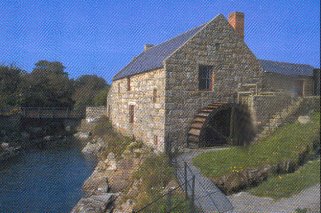Annalong has been a fishing port and harbour since the time of the Vikings. Then their boats found refuge in the ‘wee hole’ at the mouth of the Annalong River where the harbour was later built. Indeed until the gravel bar was breached at Kilkeel in the 1870s Annalong was the principal harbour along the Mourne coast. Walter Harris wrote of it in the eighteenth century: ‘of harbours along the Mourne coast that of Islealong is the best, though it will not receive any vessel but what are under 20 tons.’ We know that the breach of the bar at Cranfield opened up Carlingford Lough as far as Newry to large sea-going ships.
Prior to 1800 granite kerbstones known as kribbens were being exported from Annalong to the west coast ports of Britain in converted fishing boats. A reader here recently asked about the supply of Newry granite for the construction of the Church at Skibbereen in the last century, and though we do not know for sure, it seems likely this stone found its way there by a similar route.
As the granite industry developed purpose-built schooners were used and by 1900 a fleet of over thirty such vessels operated from the harbour. The demand for granite has changed and now large blocks of different coloured granites are imported from all over the world (mainly from China!) to be cut and polished in the village.
During the building of the Silent Valley reservoir practically all the material used was imported through Annalong from where it was transported by a purpose-built standard gauge railway to the site. Up until the Second World War Annalong had a sizable fishing fleet but the harbour was too small to accommodate the larger vessels and they moved to Kilkeel though the inshore fishermen continued to operate from Annalong where much of the catch is processed for export.
Annalong means Ford of the Ships. A corn mill near the harbour has recently been restored to working order and a fishing vessel on dry land near the marina will become the nucleus of a future Maritime Museum. The ship’s davit erected nearby is said to be from the Lusitania, the passenger ship sunk off Cork in 1915.
